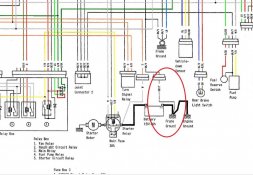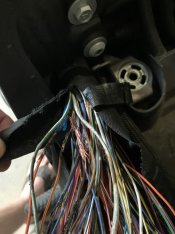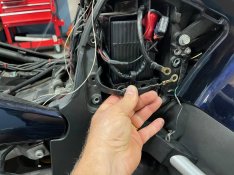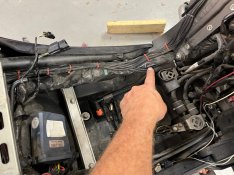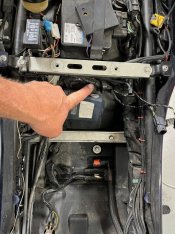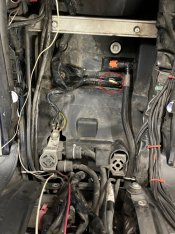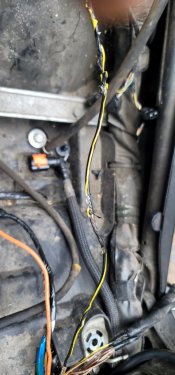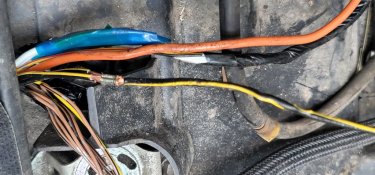This small ground wire that connects to the battery ground connection got shorted out .... don't even ask how that happened (it wasn't me).
With it disconnected I am not showing any increase in resistance back to ground, and back to the battery zero loss of voltage, not even .01 difference, so the wire seems to only suffer cosmetic damage to the insulation.
Symptoms --- bike doesn't want to start, even with booster connected to the battery. This is a new battery a week ago. Thinking the original issue was a bad battery I replaced the one that was only installed April 21, which should not have been bad, but it happens sometimes. That one is inside on charger now and apparently fine. Does not appear to be a battery issue.
So, when engaging the starter it may start, or most likely a half hearted attempt to turn over weakly once or twice, either way always accompanied by LOW BATTERY on the dash. Before starting the voltage is 12.5-12.6 and drops to 12.3 after trying to start. If it manages to start the voltage immediately jumps to 14+ depending on rpm, and 14.5-14.6 while riding. Checking with meter at battery terminals I get 14.5 from POS battery to ground wire of the battery at 2500 rpm. But, first and now current battery did not charge, so there is voltage but insufficient current.
Looking at schematics I cannot tell which items could have been damaged during the brief second long short of this wire. Regulator/Rectifier is a possibility, perhaps something with the alternator, and maybe some issue at the starter or starter relay also. Whatever it is is restricting enough current from getting to the battery to charge.
However, why does putting a booster on the battery not get enough power to the starter? That I can't understand at all. There very well may be more than one thing going on here.
Maybe I'll get lucky and someone else has had this happen ....

With it disconnected I am not showing any increase in resistance back to ground, and back to the battery zero loss of voltage, not even .01 difference, so the wire seems to only suffer cosmetic damage to the insulation.
Symptoms --- bike doesn't want to start, even with booster connected to the battery. This is a new battery a week ago. Thinking the original issue was a bad battery I replaced the one that was only installed April 21, which should not have been bad, but it happens sometimes. That one is inside on charger now and apparently fine. Does not appear to be a battery issue.
So, when engaging the starter it may start, or most likely a half hearted attempt to turn over weakly once or twice, either way always accompanied by LOW BATTERY on the dash. Before starting the voltage is 12.5-12.6 and drops to 12.3 after trying to start. If it manages to start the voltage immediately jumps to 14+ depending on rpm, and 14.5-14.6 while riding. Checking with meter at battery terminals I get 14.5 from POS battery to ground wire of the battery at 2500 rpm. But, first and now current battery did not charge, so there is voltage but insufficient current.
Looking at schematics I cannot tell which items could have been damaged during the brief second long short of this wire. Regulator/Rectifier is a possibility, perhaps something with the alternator, and maybe some issue at the starter or starter relay also. Whatever it is is restricting enough current from getting to the battery to charge.
However, why does putting a booster on the battery not get enough power to the starter? That I can't understand at all. There very well may be more than one thing going on here.
Maybe I'll get lucky and someone else has had this happen ....



